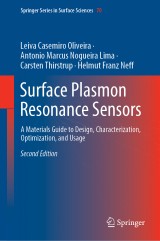Details

Surface Plasmon Resonance Sensors
A Materials Guide to Design, Characterization, Optimization, and UsageSpringer Series in Surface Sciences, Band 70 2nd ed. 2019
|
106,99 € |
|
| Verlag: | Springer |
| Format: | |
| Veröffentl.: | 13.06.2019 |
| ISBN/EAN: | 9783030174866 |
| Sprache: | englisch |
Dieses eBook enthält ein Wasserzeichen.
Beschreibungen
<p></p><p>This significantly extended second edition addresses the important physical phenomenon of Surface Plasmon Resonance (SPR) or Surface Plasmon Polaritons (SPP) in thin metal films, a phenomenon which is exploited in the design of a large variety of physico-chemical optical sensors. In this treatment, crucial materials aspects for design and optimization of SPR sensors are investigated and described in detail. The text covers a selection of nanometer thin metal films, ranging from free-electron to the platinum-type conductors, along with their combination with a large variety of dielectric substrate materials, and associated individual layer and opto-geometric arrangements. Whereas the first edition treated solely the metal-liquid interface, the SP-resonance conditions considered here are expanded to cover the metal-gas interface in the angular and wavelength interrogation modes, localized and long-range SP's and the influence of native oxidic ad-layers in the case of non-noble metals. Furthermore, a selection of metal grating structures that allow SP excitation is presented, as are features of radiative SP's. </p>
<p>Finally, this treatise includes as-yet hardly explored SPR features of selected metal–metal and metal–dielectric superlattices. An in-depth multilayer Fresnel evaluation provides the mathematical tool for this optical analysis, which otherwise relies solely on experimentally determined electro-optical materials parameters.</p><br><p></p>
<p>Finally, this treatise includes as-yet hardly explored SPR features of selected metal–metal and metal–dielectric superlattices. An in-depth multilayer Fresnel evaluation provides the mathematical tool for this optical analysis, which otherwise relies solely on experimentally determined electro-optical materials parameters.</p><br><p></p>
Introduction and background information.- Physical features of the surface plasmon polariton.- Design features of surface plasmon resonance sensors.- Modeling and data processing.- SPR-sensor properties of metal films and particles: free electron type metals.- Classical noble metals.- Noble transition metals of the platinum group.- Common transition metals.- Other common metals.- SPR active metal-type compounds.- Heavy metals.- Artificial metal-insulator multi-layer structures.- Practical Applications.- Conclusions.
<b>Leiva Casemiro Oliveira</b> is a computer scientist, who received a Ph.D. in electrical engineering at UFCG-Brazil in 2016. He is an advanced researcher on SPR technology in Brazil.<div><br><div><b>Antonio Marcus N. Lima</b> is an electrical engineer, who received his doctoral degree from INPT-Toulouse in 1989. He is a renowned researcher in the field of electrical engineering in Brazil.</div><div><br></div><div><b>Carsten Thistrup</b> received his Ph.D. in 1991 at the Technical University of Denmark; he co-founded the company Vir Biosensor.</div><div> </div><div><b>Helmut Neff</b> was a physicist, who received his Ph.D. degree from TU-Berlin in 1981. He held positions at several researcher centers around the world.</div><div><br></div></div>
<p></p><p>This significantly extended second edition addresses the important physical phenomenon of Surface Plasmon Resonance (SPR) or Surface Plasmon Polaritons (SPP) in thin metal films, a phenomenon which is exploited in the design of a large variety of physico-chemical optical sensors. In this treatment, crucial materials aspects for design and optimization of SPR sensors are investigated and described in detail. The text covers a selection of nanometer thin metal films, ranging from free-electron to the platinum-type conductors, along with their combination with a large variety of dielectric substrate materials, and associated individual layer and opto-geometric arrangements. Whereas the first edition treated solely the metal-liquid interface, the SP-resonance conditions considered here are expanded to cover the metal-gas interface in the angular and wavelength interrogation modes, localized and long-range SP's and the influence of native oxidic ad-layers in the case of non-noble metals. Furthermore, a selection of metal grating structures that allow SP excitation is presented, as are features of radiative SP's. </p>
<p>Finally, this treatise includes as-yet hardly explored SPR features of selected metal–metal and metal–dielectric superlattices. An in-depth multilayer Fresnel evaluation provides the mathematical tool for this optical analysis, which otherwise relies solely on experimentally determined electro-optical materials parameters.</p><br><p></p>
<p>Finally, this treatise includes as-yet hardly explored SPR features of selected metal–metal and metal–dielectric superlattices. An in-depth multilayer Fresnel evaluation provides the mathematical tool for this optical analysis, which otherwise relies solely on experimentally determined electro-optical materials parameters.</p><br><p></p>
Greatly expanded new edition with descriptions of many new SPR systems and their properties A valuable reference source for all researchers working on surface plasmons in metal films Contains important details for a range of applications of SPR including spectroscopy, imaging and materials evaluation
Diese Produkte könnten Sie auch interessieren:

Introduction to Focused Ion Beams

von: Lucille A. Giannuzzi, Lucille A. North Carolina State University

128,39 €















